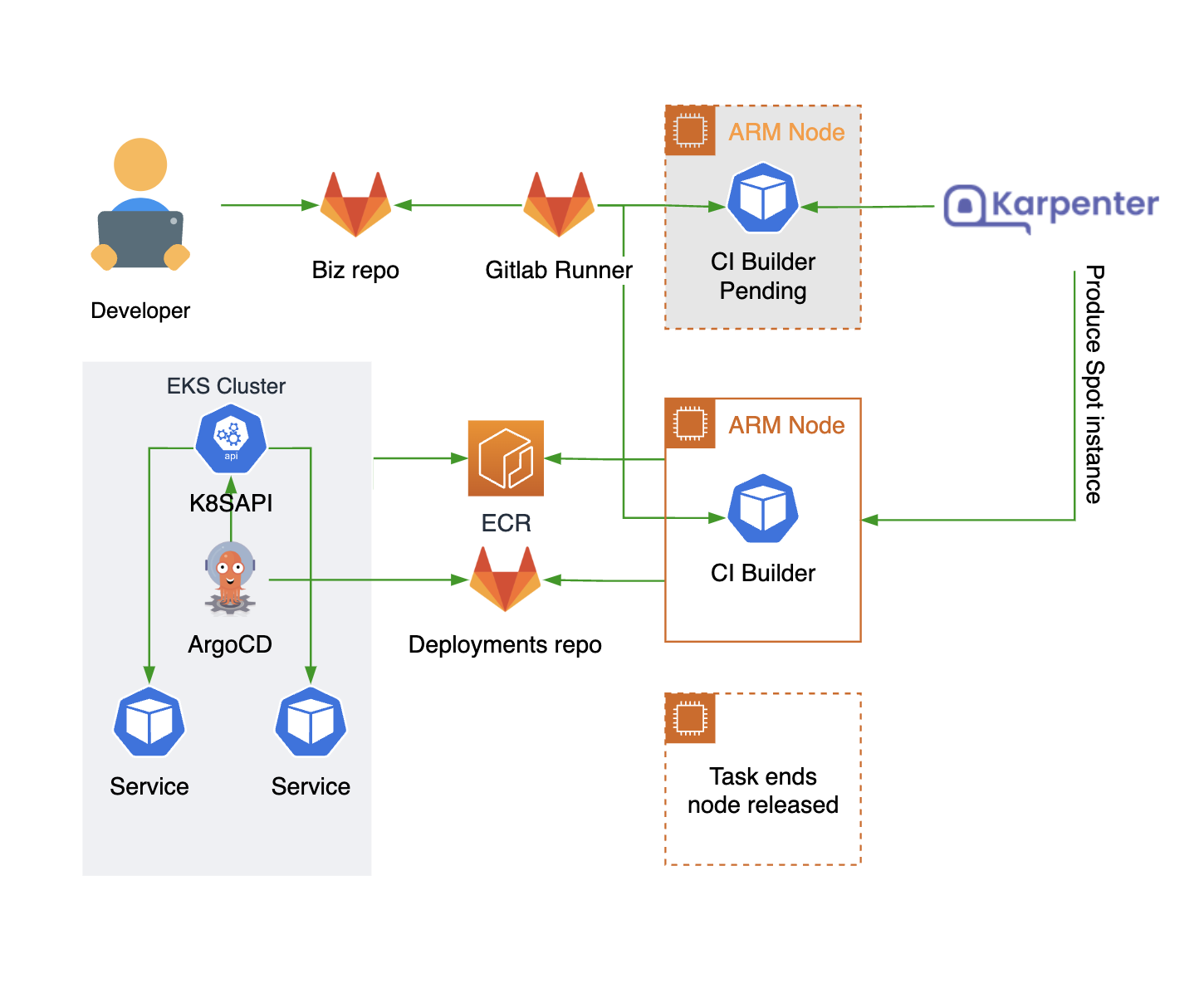The cheapest way to build applications (Gitlab CI) on AWS
Graviton (ARM) is the most cost-effective in AWS (up to 40% savings), while Spot instances are suitable for task-type workloads and can save up to 90%. Gitlab Runner can easily schedule build tasks to Graviton + Spot instances.
Config Gitlab runner
First, we need to tag the Gitlab runner. Here I set the tag to arm. Later we will schedule the task to the runner.
Here is the CDK code:
cluster.addHelmChart("arm-runner", {
chart: "gitlab-runner",
repository: "http://charts.gitlab.io/",
version: "0.48.0",
namespace: "gitlab",
release: "arm-runner",
createNamespace: false,
values: {
runnerRegistrationToken: "<your-runner-token>",
gitlabUrl: "<your-gitlab-url>",
privileged: true,
rbac: {
create: true,
rules: [
{
apiGroups: [""],
resources: ["pods"],
verbs: ["list", "get", "create", "watch", "delete"],
},
{
apiGroups: [""],
resources: ["pods/exec"],
verbs: ["create"],
},
{
apiGroups: [""],
resources: ["pods/log"],
verbs: ["get"],
},
{
apiGroups: [""],
resources: ["pods/attach"],
verbs: ["list", "get", "create", "update", "delete"],
},
{
apiGroups: [""],
resources: ["secrets"],
verbs: ["list", "get", "create", "update", "delete"],
},
{
apiGroups: [""],
resources: ["configmaps"],
verbs: ["list", "get", "create", "update", "delete"],
}
]
},
runners: {
name: "arm-runner",
tags: "arm, mass",
runUntagged: false,
helpers: {
image: "gitlab/gitlab-runner-helper:arm64-v14.10.2"
},
config: `
[[runners]]
name = "arm-runner"
environment = ["FF_USE_LEGACY_KUBERNETES_EXECUTION_STRATEGY=true"]
executor = "kubernetes"
[runners.kubernetes]
image = "ubuntu:22.04"
privileged = true
[[runners.kubernetes.volumes.empty_dir]]
name = "docker-certs"
mount_path = "/certs/client"
medium = "Memory"
[[runners.kubernetes.volumes.empty_dir]]
name = "dind-storage"
mount_path = "/var/lib/docker"
[[runners.kubernetes.volumes.host_path]]
name = "hostpath-modules"
mount_path = "/lib/modules"
read_only = true
host_path = "/lib/modules"
[[runners.kubernetes.volumes.host_path]]
name = "hostpath-hosts"
mount_path = "/etc/hosts"
read_only = true
host_path = "/etc/hosts"
[[runners.kubernetes.volumes.host_path]]
name = "hostpath-cgroup"
mount_path = "/sys/fs/cgroup"
host_path = "/sys/fs/cgroup"
[runners.kubernetes.node_selector]
"karpenter-arch" = "arm64"
`
},
}
});
Some notices:
- Under ARM env, we need to specify the gitlab-runner-helper image, because the helper image is single-arch, default pattern is X86. This image will run as a sidecar for the build task.
FF_USE_LEGACY_KUBERNETES_EXECUTION_STRATEGYmust be sett to true to execute pod.[runners.kubernetes.node_selector]is prepared for K8S pod scheduling, which means the build tasks will be scheduled to the node node of the corresponding tag.
Karpenter Provisioner
Karpenter is a K8S node auto scaler built by AWS.
Here is the Karpenter Provisioner code.
apiVersion: karpenter.sh/v1alpha5
kind: Provisioner
metadata:
name: arm-builder
spec:
requirements:
- key: "karpenter.k8s.aws/instance-category"
operator: In
values: ["c", "m", "r"]
- key: karpenter.sh/capacity-type
operator: In
values: ["spot"]
- key: "kubernetes.io/arch"
operator: In
values: ["arm64"]
limits:
resources:
cpu: 1000
labels:
karpenter-arch: arm64
providerRef:
name: default
ttlSecondsAfterEmpty: 30
---
apiVersion: karpenter.k8s.aws/v1alpha1
kind: AWSNodeTemplate
metadata:
name: default
spec:
amiFamily: Bottlerocket
subnetSelector:
"aws:cloudformation:stack-name": gitlab
"aws-cdk:subnet-type": Private
securityGroupSelector:
"kubernetes.io/cluster/gitlab": owned
Notices:
- You can specify instance categories, CPU types, payment types, etc.
- We choose arm cpu and spot capacity type, this combination is the cheapest.
- It is recommended to use Bottlerocket as the os of node. Using Amazon Linux will throw an error that “Cannot resolve DNS address of the git repository”.
Gitlab CI config
Now we need to schedule the build task to this runner.
Here is an example .gitlab-ci.yml code:
stages:
- Build
frontend-build:
stage: Build
image: node:16.16.0-alpine
tags:
- arm
script:
- npm install
- npm run build
artifacts:
paths:
- build/
You only need to specify the tags for the build task.
Summary
Through the above three configurations, the overall CI process is as follows:
Trigger Gitlab build -> Look for runner with arm tag -> Start build task (pod) -> Look for karpenter-arch: arm64 node -> No arm node, pod pending -> Karpenter purchase arm + spot node -> The build task starts -> The task ends and the node is released.
As shown in the figure below:

A whole new node purchase time is about 1 min 30s, Karpenter will always look for the cheapest instance.